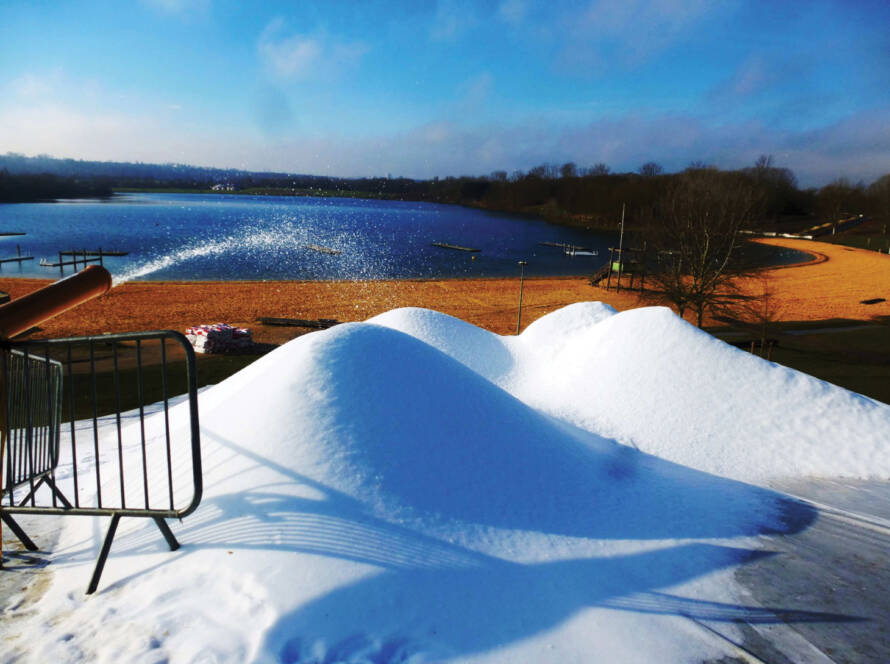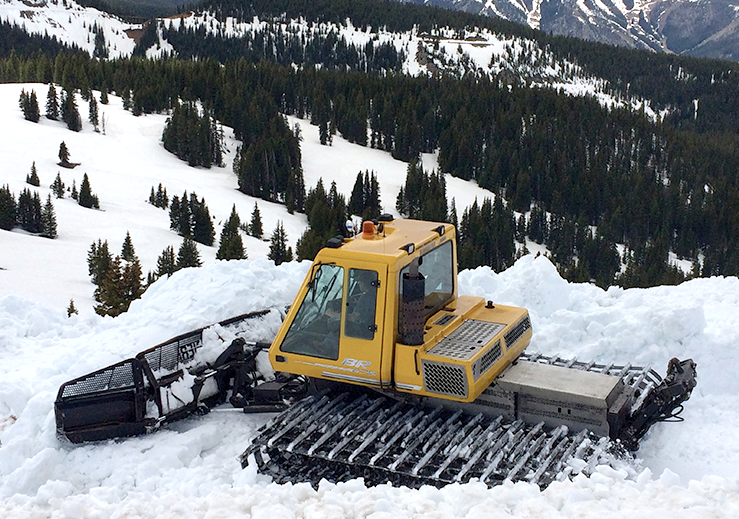As the owner of STAR Towing, a partner in Snowmobile Trailside Rescue (STR) and the designer and fabricator of the Towmobile, Domenic Lacaria said that he is finally combining “my love for designing and building things, my love for helping people and being a service guy, and my love for snowmobiling.”
Snowmobile Towing Assistance and Recovery (STAR), offers towing, fuel delivery, battery boosts, recovery of vehicles that have gone off the trail or rolled over, minor trailside repairs and accident clean-up, to “return the trail to a safe condition, so that no one else hits it and gets hurt,” said Lacaria.
“My heart’s always been with snowmobiling. For years, I’ve thought about when you break down in the bush, you have to rely on a passerby and flag them down, see if they’ll give you a ride, tow you. I’ve broken down many times, been stranded and all that – it’s not safe. And if you get stuck in the evening, when there’s no traffic on the trails, you’re stuck for the night out freezing.”
After earning his mechanical and materials engineering degree in 2016 from the University of Western Ontario (now Western University), “I could finally do something about it,” he said. When “things slowed down in 2018, I thought, ‘This is a perfect time to jump in.’” His innovative Towmobile was just one of the results.
Lacaria spent a year-and-a-half designing and building the prototype Towmobile in his London, Ont., shop, adapting a service-truck crane and mounting it on a modified Italian Alpina Sherpa “work” snowmobile, which he lengthened to 5.5 meters. The machine has a dual 50-centimeter-wide by 400-centimeter-long track.
What makes it unique is its 4.5-meter-long custom-built rotating crane, which is operated hydraulically with wireless controls and four winches – two with three tonnes of lifting capacity, each with over 70 meters of cable length, plus extensions, and two with two tonnes of capacity each, that enable the operator to lift a snowmobile “far off the trail – even down a cliff,” straight up into the air and back onto the trail “with one shot,” says Lacaria. It’s a job that otherwise “might take six guys with lifts and pulleys half a day.”
He added another winch under the front of the vehicle to provide an additional five-tonne towing capacity and adjustable outriggers to support the machine’s lifting capabilities in soft snow or uneven terrain. The vehicle’s heated cab, which also has a heated driver’s seat, can accommodate two passengers in addition to the driver, and achieves a top speed of 60 kilometers an hour.
“The machine is very stable – it can lift four times the weight of a snowmobile with no issues, well within the limit of safety,” said Lacaria, who has begun the process of applying for patents for some of the machine’s innovations.
Licensed to travel Ontario’s snowmobile trails
“Right now there’s nothing else in existence that’s allowed to go down the snowmobile trails – that’s how the Motorized Snow Vehicle Act is set up,” Lacaria said, but since the Towmobile has been licensed to travel Ontario’s snowmobile trail system, he anticipates growing demand for STAR’s services in the future. “I’ve been talking with the Ontario Provincial Police, who are saying that they’ll call me every time they impound a snowmobile or come across an accident, and they get calls very often, several times a week.”
Lacaria was preparing to bring his Towmobile north to Timmins, Ont., from his London shop early in 2020, “two days before the trails were all shut down due to the lockdown,” he said. Despite the ongoing Covid-19 pandemic, he was finally able to get STAR Towing up and running for this past winter’s shortened two-month season, which ended in mid-March in that region.
Starting in Timmins with plans to grow
“I’m starting in the Timmins area,” he said. STAR Towing’s rescue service currently covers part of a trail network in northeastern Ontario, from Kapuskasing, Cochrane, Iroquois Falls, and down Highway 11 to New Liskeard. “Each year, we’ll be looking to expand our coverage area. As we grow, we’ll expand to the rest of the province,” eventually to other provinces and the northern U.S. In Ontario alone there are about 30,000 kilometers of trails maintained by the Ontario Federation of Snowmobile Clubs.
Since Lacaria posted photos of the Towmobile on the STAR Towing Facebook page earlier this year, potential buyers and investors have been calling him from all over. He said, “the northeastern states, Wisconsin, Michigan, and Minnesota – one guy said he’d try one out and if he convinced all the clubs in his area, could probably put in an order for 30 machines!” Due to the custom-built and one-off components, the prototype Towmobile was expensive to build, says Lacaria, but he estimates that once he’s able to buy parts and produce the machines in quantity, possibly with some modifications, his sale pricing will be much lower.
Lacaria is also partnering in the development of the STR network, a membership-based towing dispatch service “similar to CAA [or AAA], but for snowmobiles,” he said.
The thousands of snowmobilers coming to the northern region around Timmins, Cochrane, and Hearst are the ones most likely to buy an STR membership and rely on its services, he says.
“They fill the hotel rooms and snowmobile for a week or two straight, and when they break down, [they] don’t know anybody in the area to call and come get them. Now people can buy a membership for the service for the season and then don’t have to pay for the tow when they need it – you can call someone in the middle of the night in -40°C to come get you – versus a 30-mile walk back to the road.”
Sturdy four-ski sleigh designed to tow heavy loads
“For most of the calls someone has blown an engine,” or has a similar issue, Lacaria says. The tow straps and bars currently on the market that hook to the front of a snowmobile or the ski loops usually require a second rider on the back to steer and can wreck a machine’s alignment; and the snowmobile must be towable on its own skis and track.
With towing products that are meant to be put under the track “sort of like a Crazy Carpet, you’re still relying on the skis being straight and in alignment,” he said, but “if a front control arm has broken off, say, and you tow it with a rope, it’ll just dig into the snow.”
For such situations Lacaria has built a custom four-ski sleigh sturdy enough to handle heavy loads and designed to be towed behind a wide-tracked work snowmobile. The sleigh’s flatbed is tiltable and equipped with a winch, so that “if the track’s not turning or is ripped off, [or] the skis are bent, as long as you can drag it up onto the sleigh, then it’s like dragging a mangled car onto a flatbed tow truck.”
“STR and STAR Towing are two separate businesses and are being kept that way,” he said, but part of his business plan for both is to enlist tow companies in other regions to widen STR’s network of service providers and to supply those operators with his towing equipment, which they’ll be able to buy or lease.
“Right now it’s basically me running it all, but I have some people who will help and will run different areas, different machines and different zones, so we’ll be dispatched faster to different areas,” said Lacaria. “It’s a two- to two-and-a-half-hour response-time operational radius now, but as I expand, I’ll have more equipment, more people and a bigger coverage area. Depending on how far out and deep in the bush the stranded person is, I’d like to have the expected arrival time down to within an hour of getting the call.”



